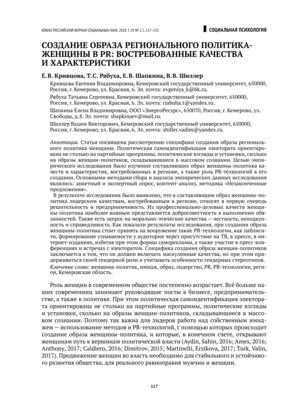Abstract
The article analyses the specific character of a regional female politician’s image making. The political self-identification of the electorate is not so much oriented towards party programs, political views and attitudes, as towards images of female politicians which are taking shape in mass consciousness. The aim of the empirical research was to study the qualities and characteristics of a female politician’s image that are required in Kemerovo Oblast’, as well as the role of PR technologies in its making. The main methods of collecting and analyzing the empirical data were questionnaire and expert surveys, content analysis, and the method known as “Unfinished sentences” technique. The analysis has revealed that the major leadership qualities that compose a female politician’s image in Kemerovo Oblast’ are determination and enterprise, in the first place. For business-oriented professional female politicians, it is most necessary to be conscientious in doing one’s duty. Besides, such moral and ethical characteristics as honesty, integrity / incorruptibility and fairness / justice are in great demand. According to the results of the research, to create a successful female politician’s image, it is necessary to resort to some PR technologies, such as publicity, TV appearances, and press and Internet coverage, press conferences and meetings with the electorate, but without any form of self-advertising. The specifics of a female politician’s image is that it should combine both male and female characteristics, yet keep within the framework of its gender and take into account gender stereotypes.
Keywords
References
- Amelin, V. N. & Ustimenko, S. V. (2011). Tekhnologiya izbiratel’noy kampanii [The technology of an electoral company]. Moscow: Izdatel’skiy dom Grebennikova.
- Ames, C. (2016). Entertainment Public Relations. Peter Lang GmbH, Internationaler Verlag der Wissenschaften. DOI: https://doi.org/10.3726/978–1–4539–1775–6.
- Anthony, S. (2017). Public relations and the making of modern Britain: Stephen Tallents and the birth of a progressive media profession: Monograph. Manchester University Press. DOI: https://doi.org/10.2307/j.ctv6p52v.
- Arcos, R. (2016). Public relations strategic intelligence: Intelligence analysis, communication and influence. Public Relations Review, 42 (2), 264–270. DOI: https://doi.org/10.1016/j.pubrev. 2015.08.003.
- Aydin, B. O. & Sahin, E. (2016). Research Methods and Techniques in Public Relations and Advertising. Peter Lang GmbH, Internationaler Verlag der Wissenschaften. DOI: https://doi.org/10.3726/b10899.
- Bochkova, E. A. (2010). Mekhanizmy PR-texnologiy v imidzhe sovremennogo politika [Mechanisms of PR technologies in the image of a modern politician]. Akademiya Trinitarizma.
- Bukharova, O. V. (2007). Imidzh lidera: tekhnologiya sozdaniya i prodvizheniya [The image of a leader: the technology of creation and promotion]. St. Petersburg: Rech’.
- Caldiero, C. (2016). Neo-PR. Public Relations in a Postmodern World. Peter Lang Inc., International Academic Publishers. DOI: https://doi.org/10.5040/9781501319457.
- Dergach, A. A. (2006). Politicheskaya imidzhelogiya [Political imageology]. Moscow.
- Dimitrov, R. (2015). Silence and invisibility in public relations. Public Relations Review, 41 (5), 636–651. DOI: https://doi.org/10.1016/j.pubrev.2014.02.019.
- Dmitriev, A.V., Latynov, V.V. & Yakovlev, I.G. (2002). Politika, politologiya, Internet [Politics, political science, Internet]. Moscow: Modern Humanities University.
- Dobrioglo, M. A. (2005). Spetsifika razvitiya zhenskogo dvizheniya kak sub’ekta politicheskogo protsessa [The specifics of the development of the women’s movement as a subject of the political process]. Vestnik Pyatigorskogo gosudarstvennogo lingvisticheskogo universiteta, 1, 70–74.
- Dudin, D. M. (2009). Obraz politicheskogo lidera i vozmozhnosti yego izmeneniya [The image of a political leader and the possibilities of its alteration]. Pskov: Prospekt.
- Golan, Guy J., Yang, Sung-Un & Kinsey, D. F. (2015). International Public Relations and Public Diplomacy. Peter Lang Inc., International Academic Publishers. DOI: https://doi.org/10.3726/978–1–4539–1432–8.
- Grinberg, T. E. (2010). Politicheskaya reklama: portret lidera [Political advertising: A portrait of the political leader]. Moscow: Aspekt Press.
- Kovler, A. I. (2005). Izbiratel’nye tekhnologii: rossiyskiy i zarubezhnyy opyt [Electoral technologies: Russian and foreign experience]. Moscow: IGiP RAN.
- Maier, C. T (2015). Public relations as humane conversation: Richard Rorty, stakeholder theory, and public relations practice. Public Relations Inquiry, 4 (1), 25–39. DOI: https://doi.org/10.1177/ 2046147x14554140.
- Martinelli, D. & Erzikova E. (2017). Public relations leadership development cycle: A cross-cultural perspective. Public Relations Review, 3 (5), 1062–1072. DOI: https://doi.org/10.1016/ j.pubrev.2017.09.002
- Mengü, S. & Mengü, M. (2016). Making Sense of Public Relations as Culture Policy. Journalism and Mass Communication, 6 (10). DOI: https://doi.org/10.17265/2160–6579/2016.10.008.
- Mogensen, K. (2017). From public relations to corporate public diplomacy. Public Relations Review, 43 (3), 605–614. DOI: https://doi.org/10.1016/j.pubrev.2017.03.011.
- Molchanov, K. A. (2013). Sotsial’nyye tekhnologii formirovaniya optimal’nogo imidzha politicheskogo lidera [Social technologies of formation of the optimal image of a political leader]. Vserossiyskiy zhurnal nauchnykh publikatsiy, 3, 52–53.
- Morozova, E. G. (2010). Politicheskiy rynok i marketing: kontseptsii, modeli, tekhnologii [Political market and marketing: concepts, models, technologies]. St. Petersburg: Prospekt.
- Ofitsial’nyi sayt Tsentral’noy izbiratel’noy komissii Rossiyskoy Federatsii [The official website of the Central Election Commission of the Russian Federation]. Retrieved from http://www.cikrf.ru.
- Patterson, T. (2009). Imidzh politika: teoreticheskiye problemy, metody analiza [The image of a politician: theoretical problems and methods of analysis]. Moscow: INFRA.
- Potemkina, O. F. (2010). Imidzh politicheskogo lidera [The image of a political leader]. Moscow: Prospekt.
- Shakhtarina, M. V. (2000). Problemy uchastiya molodykh rossiyskikh zhenshchin v politike [The problems of participation of young Russian women in politics]. Sotsiologicheskii sbornik, 7, 108–115.
- Sheynov, V. P. (2008). Psikhologiya liderstva, vliyaniya, vlasti [Psychology of leadership, influence, and power]. Minsk: Harvest.
- Singh, A. & Duhan P. (2016). Managing Public Relations and Brand Image through Social Media. IGI Global. DOI: https://doi.org/10.4018/978–1–5225–0332–3.
- Slepenkov, I. M. (2005). Izbiratel’naya kampaniya: strategiya, taktika, psikhologicheskiye aspekty [Election campaign: strategy, tactics, psychological aspects]. Moscow: Tsentr izbiratel’nykh tekhnologiy.
- Tsuladze, A. M. (2002). Formirovaniye imidzha politika v Rossii [Formation of the image of a politician in Russia]. Moscow: Knizhnyy dom “Universitet”.
- Turk, Judy Van Slyke & Valin J. (2017). Public Relations Case Studies from Around the World (2nd Edition). Peter Lang Inc., International Academic Publishers. DOI: https://doi.org/10.3726/ b11746.
 Русский
Русский

